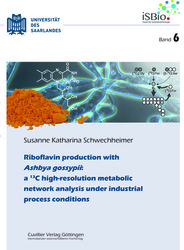| Departments | |
|---|---|
| Book Series (96) |
1378
|
| Nachhaltigkeit |
3
|
| Gesundheitswesen |
1
|
| Humanities |
2363
|
| Natural Sciences |
5406
|
| Mathematics | 229 |
| Informatics | 319 |
| Physics | 980 |
| Chemistry | 1363 |
| Geosciences | 131 |
| Human medicine | 243 |
| Stomatology | 10 |
| Veterinary medicine | 108 |
| Pharmacy | 147 |
| Biology | 835 |
| Biochemistry, molecular biology, gene technology | 121 |
| Biophysics | 25 |
| Domestic and nutritional science | 45 |
| Agricultural science | 1004 |
| Forest science | 201 |
| Horticultural science | 20 |
| Environmental research, ecology and landscape conservation | 148 |
| Engineering |
1791
|
| Common |
98
|
|
Leitlinien Unfallchirurgie
5. Auflage bestellen |
|
Advanced Search
Riboflavin production with Ashbya gossypii (Volume 6) (English shop)
A 13C high-resolution metabolic network analysis under industrial process conditions
Susanne Katharina Schwechheimer (Author)Preview
Extract, PDF (2.4 MB)
Table of Contents, PDF (640 KB)
The fungus Ashbya gossypii is an important industrial producer of riboflavin, i.e. vitamin B2. Here, we developed and then used a highly sophisticated set-up of parallel 13C tracer studies with labeling analysis by GC/MS, LC/MS, 1D, and 2D NMR to resolve carbon fluxes and obtain a detailed picture of the underlying metabolism in the overproducing strain A. gossypii B2 during growth and riboflavin production from a complex industrial medium using vegetable oil as carbon source. Glycine was exclusively used as carbon-two – but not carbon-one (C1) – donor of the vitamin’s pyrimidine ring due to the proven absence of a functional glycine cleavage system. Yeast extract was the main carbon source during growth, while still contributing 8 % overall carbon to riboflavin. Overall carbon flux from rapeseed oil into riboflavin equaled 80 %. Transmembrane formate flux simulations revealed that the C1-supply displayed a severe bottleneck during the initial riboflavin production, which was overcome in later phases of the cultivation by intrinsic formate accumulation. The transiently limiting C1-pool was successfully replenished by time-resolved feeding of formate or serine. This increased the intracellular precursor availability and resulted in a riboflavin titer increase of 45 %. This study is the first that successfully sheds light on carbon fluxes during the growth and riboflavin production phase by use of 13C tracers and a complementary platform of analytical techniques.
| ISBN-13 (Hard Copy) | 9783736998810 |
| ISBN-13 (eBook) | 9783736988811 |
| Final Book Format | A5 |
| Language | English |
| Page Number | 174 |
| Lamination of Cover | matt |
| Edition | 1. |
| Book Series | Hochschulschriften - Institut für Systembiotechnologie, Universität des Saarlandes |
| Volume | 6 |
| Publication Place | Göttingen |
| Place of Dissertation | Saarbrücken |
| Publication Date | 2018-11-26 |
| General Categorization | Dissertation |
| Departments |
Microbiology and biotechnology
|
| Keywords | Ashbya gossypii, Riboflavin, Vitamin B2, 13C tracer, 13C Metabolic flux analysis, Isotope labeling, GC/MS, LC/MS, NMR, Yeast extract, Industrial process, Systems biotechnology, Industrial biotechnology, Metabolic network analysis, Bacillus subtilis, Carbon-one metabolism, Glycine metabolism, Vegetable oil, Rapeseed oil, Overproducer, Vitamin, Riboflavin biosynthesis, Purine biosynthesis, Metabolic engineering, Positional enrichment, Biotechnology, Parallel tracer experiments |








